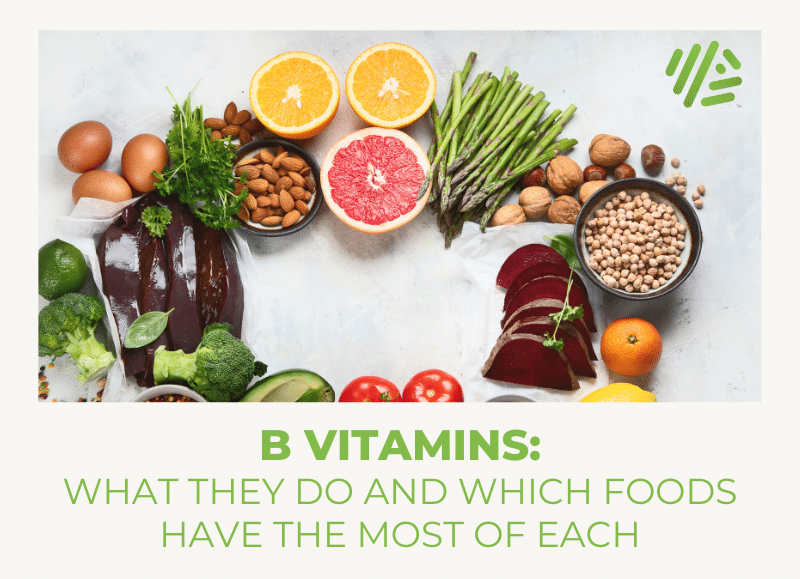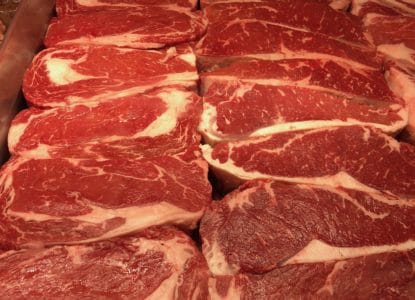B vitamins: What They Do and Which Foods Have the Most of Each
Genes Mentioned

B vitamins are a class of water (as opposed to fat) soluble vitamins which play an important role in many cellular processes. When present in supplements individually, B vitamins are referred to by their individual name, for example, vitamin B1. When all are present they are often termed “vitamin B complex.” Below is a quick summary table of the B vitamins, the potential harmful effects arising from a lack of each, and where available, information about the recommended daily amount of each.
| Vitamin | Alternative Name | Brief Function |
| B1 | Thiamine | Breakdown of sugars and amino acids |
| B2 | Riboflavin | DNA repair, ATP (the energy currency of the body) generation |
| B3 | Niacin | ATP generation |
| B5 | Pantothenic acid | Breakdown of sugars and amino acids, synthesis of fatty acids and amino acids |
| B6 | Pyridoxine | Synthesis of amino acids |
| B7 | Biotin | Fatty acid synthesis, break down of sugars |
| B9 | Folic acid | DNA synthesis and repair, important for rapid cell division |
| B12 | Hydroxocobalamin | DNA synthesis and repair, fatty acid and amino acid synthesis |
Vitamin B1 – Thiamine
Thiamine’s major role is to act as a coenzyme (helps catalyse a reaction) involved in the breakdown of sugars and amino acids into their constituent parts. These are then available to be used to make other molecules required by the body. As such, a severe deficiency in thiamine can prove fatal with symptoms including weight loss, loss of sensory perception, weakness, pain, increased heart rate, and shortness of breath. These symptoms are sometimes taken together and classed as Beriberi disease, although it is also commonly referred to as thiamine deficiency. Whilst very severe cases are rapidly identified, low level occurrences of these symptoms can pass unnoticed for many years or often be misdiagnosed.1 However, a relatively simple blood test is possible.
Highest thiamine foods
Thiamine is readily available in many foods, including numerous foods containing yeast based products or cereal grains, in particular those containing the wholegrain. Other rich food sources include:
- asparagus
- kale
- liver and eggs.
For adults the Recommended Dietary Allowances (RDA) are 1.2 mg in men and 1.0 mg in women, rising to 1.4 mg during pregnancy and breastfeeding.
Vitamin B2 – Riboflavin
Riboflavin acts as coenzyme and plays a major role in the production of ATP, the body’s “energy currency”. Deficiencies in riboflavin are uncommon in the West as many of our foods are enriched during their processing. However, when Riboflavin deficiency is present, symptoms can include inflammation of the skin, especially around the lips and the mouth, light sensitivity and anaemia. In very severe cases there is a severe lack of energy which eventually leads to the collapse of the bodies systems. However, this is incredibly rare and often associated with severe malnutrition.2
Highest vitamin B2 foods
Outside of the widely available fortified foods, these foods are highest in B2:
- liver
- milk
- mushrooms
- spinach
- almonds
The RDA for men over the age of 14 is 1.3 mg per day and 1.0 mg per day in women rising to 1.4 mg during pregnancy and 1.6 mg during breastfeeding. Interestingly, when added to a B complex formula or a multivitamin, B2 seems to have a protective effect against an increased cancer risk associated with high doses of certain B vitamins.
Vitamin B3 – Niacin
Niacin is the most common form of vitamin B3, with nicotinamide being another common form. As with riboflavin, both niacin and nicotinamide play an important role in the generation of ATP, but are also important in the breakdown of dietary fats, carbohydrates and proteins and the synthesis of carbohydrates and fatty acids. As with riboflavin, deficiency of niacin leads to the development of inflammatory disorders, but also similarly to riboflavin this is now incredibly rare in the West due to fortification of foods.3 One interesting usage of niacin, but not nicotinamide, is as a lipid-lowering medication. Acting to reduce the amount of low-density lipoproteins and increase the amount of high-density lipoproteins. Although as we know from this previous post such an effect may not be entirely desirable.3
Niacin rich foods
Foods rich in niacin include:
- liver
- tuna
- salmon
- avocados
- leafy vegetables
- dates
- wholegrain cereals
The RDA for men is 16 mg per day and 14 mg per day for women with an upper limit of 35 mg per day for each. At doses exceeding this there are some mild side-effects including facial flushing whereby blood rushes to the face causing a redness and tingling.
Vitamin B5 – Pantothenic acid
Pantothenic acid is a cofactor used in the synthesis of coenzyme A, which is important in the synthesis of fatty acids and the generation of ATP. As the “pan” in its name would suggest, pantothenic acid is found in nearly every food, in part because it is so vital to life. Deficiency in pantothenic acid is virtually unheard of as it is so prevalent in the diet, although some small trials have described similar effects to those seen with other B vitamin deficiencies.4
Foods highest in pantothenic acid
- Organ meats and beef
- eggs and milk
- shiitake mushrooms
- brown rice
- oats
- chickpeas
The RDA for pantothenic acid has been set at 5 mg per day for men and women, increasing to 7 mg per day for pregnant and breastfeeding women. No upper limit or side effects have been described.
Vitamin B6 – Pyridoxine
Pyridoxine is vital in the synthesis of amino acids and important neurotransmitters such as serotonin, dopamine and GABA. Deficiency of pyridoxine gives rise to similar symptoms described above including inflammation and a lack of energy or confusion. Although severe deficiency is uncommon, low level deficiency can be relatively common and as with other B vitamin deficiencies can be missed or misdiagnosed.
Foods rich in vitamin B6
Foods rich in pyridoxine include:
- chickpeas
- bananas
- pork
- beef
The RDA for pyridoxine is 1.7 mg per day for men and women rising to 2.0 mg per day for pregnant and breastfeeding women. As with all B vitamins pyridoxine is water soluble meaning that excessive doses are often passed out in urine. However, continued very high doses of pyridoxine are associated with very severe side effects including the development of heart arrhythmia and neurological damage. Confusingly, the maximum recommended dose varies quite widely, set at 10 mg per day in the UK, 25 mg per day by the EU and 100 mg per day in the US.
Vitamin B7 – Biotin
Biotin is required for the production of fatty acids, and the breakdown of sugars, potentially to maintain blood sugar level. Biotin is commonly recommended as a dietary supplement for the strengthening of nails and hair. These claims arise from the fact that these symptoms arise when biotin is deficient, as well as other more common B vitamin deficiencies including inflammation of the skin. However, data supporting a beneficial effect in those already obtaining the required amount of dietary biotin is weak.56 Whilst severe deficiency is rare, mild deficiency may be relatively common due to dietary deficiencies.
Foods rich in biotin
Rich dietary sources include:
- leafy green vegetables
- nuts
- egg yolks (but not the whites which contain avidin which neutralises biotin)
Importantly there is no current RDA for biotin, rather there are “Adequate Intakes” which are meant to act as a guide until better information is available. These are currently set at 30 μg per day for both men and women.
Vitamin B9 – Folic acid
Vitamin B9 is perhaps the most famous of all the B vitamins due to its important role in pregnancy and early infancy. Folic acid is converted into tetrahydrofolic acid which acts as a cofactor in many cellular reactions, but especially the synthesis of amino acids and nucleic acids, vital for rapid cell division. Times when rapid cell division is important? During pregnancy and early infancy, and also in the production of red blood cells which have a rapid turnover within the body. As you can imagine, a deficiency of folic acid is associated with some poor health effects. In pregnancy a lack of folic acid was linked with the risk of neural tube and congenital heart defects which are a major causes of miscarriage and early infant death.78 As such folic acid supplementation is strongly recommended before and during pregnancy and also in the babies diet after birth. Outside of pregnancy folate deficiency can lead to a variety of symptoms including depression, confusion, anaemia and fatigue.9 Anaemia caused by a lack of red-blood cell production may be the major symptom here driving the development of the other symptoms such as depression and fatigue as the brain is not being supplied with sufficient energy.
Folate rich foods
Foods rich in folic acid include:
- leafy green vegetables such as spinach or kale
- citrus fruits
- egg
- lentils
- liver
Fortified bread The RDA for folic acid varies by age and sex. For those over 14 years old a dose of 400 μg (microgram) per day is recommended, increasing to 600 in pregnant women and 500 in breastfeeding women. An upper limit of 1,000 μg per day has been recommended although no harmful effects have been associated with high levels of consumption. Interestingly there is some suggestion that high intakes of folic acid can mask vitamin B12 deficiency which can be much more serious, although no in-depth study has yet been performed.10
Vitamin B12 – Hydroxocobalamin
Finally, to hydroxocobalamin. The most important role of hydroxocobalamin is in the synthesis of DNA in a similar fashion to folic acid, hence why it is possible for an excess of folic acid to mask a deficiency of hydroxocobalamin. Whilst there is a large overlap in function between the two hydroxocobalamin seems to also play an important role in the maintenance of adult neurological tissue in the brain. As such a deficiency can lead to several severe neurological disorders such as a loss of sensation, dementia and other neurological conditions, which unlike other vitamin B deficiencies may not be reversible.1112 Some people who suffer from B12 deficiency opt for a shot of B12.
Animal foods are highest in B12
Most animal derived foods including fish, meat, poultry and eggs are rich in hydroxocobalamin meaning vegetarians or vegans are strongly recommended to supplement their diet. A RDA of 2.4 μg per day for men and women has been set, rising to 2.8 μg per day in pregnant and breastfeeding women. No adverse effects have been associated with excess vitamin B12 intake from food or supplements in healthy individuals.
Final Remarks
So hopefully that’s given you some understanding of the role of the various B vitamins, their sources and the potential effects arising from a deficiency. Eating a healthy, varied diet rich in dark green vegetables, whole grains and meats should provide sufficient quantities of all B vitamins. However, whilst it is often easy to identify severe cases of B vitamin deficiency, milder low-level deficiencies are often easily missed, or misdiagnosed. But with readily available tests to check the levels of your B vitamins and numerous supplements this should not be something impacting your health.




What is the best time of day to take folic acid?
Peter, since B vitamins can give a kick of energy, the best time to take them for most people is in the morning with breakfast.
Dig into folate vs. folic acid, the synthetic version. They are not the same thing. Some people have had a genetic mutation that prevents detox from ingestion of folic acid. This is why mandatory vaccination is so dangerous, some children are homozygous for the defect (they got the defective gene from both parents).
this helps me so much. thank you!
Hi, you might be able to give me a clue. My body has started to store dangerous levels of b6 with no explanation. Could you give me a hint at which systems I should be looking at to try and identify why this is happening?
Hi Violette,
If your vitamin B6 levels are dangerously elevated you should definitely discuss this with your doctor or a healthcare professional.
To try and help you pinpoint things can I ask if you’re talking a multi-vitamin or a complex B vitamin supplement?